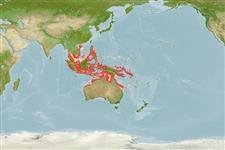Common names from other countries
Environment: milieu / climate zone / depth range / distribution range
Ecologia
marinhas associadas(os) a recifes; não migratória; intervalo de profundidade 1 - 50 m (Ref. 9710). Tropical; 20°N - 24°S, 97°E - 163°E (Ref. 5222)
Western Pacific: Philippines to Australia (Dampier Islands, off Western Australia to the Capricorn Islands, of the southern Great Barrier Reef); including Palau, New Britain, and the Solomon Islands.
Tamanho / Peso / Idade
Maturity: Lm ? range ? - ? cm
Max length : 55.0 cm TL macho/indeterminado; (Ref. 118794)
Espinhos dorsais (total) : 9; Raios dorsais (total) : 15 - 17; Espinhos anais: 3; Raios anais : 7 - 8. Juveniles dark brown with bright yellow dorsal, anal, pelvic and tail fins. At size about 9 cm, small scattered blue dots appear and yellow on fins begins to recede (Ref. 37816); characterized further by brown to reddish brown color, usually mottled; head, body and fins covered with numerous white to bluish spots; several pale bars evident on side; scales ctenoid scales on body including abdomen; greatest body depth 2.6-3.0 in SL; rounded caudal fin; pelvic fins 1.8-2.1 in head length (Ref. 90102).
Inhabits shallow protected coastal reefs, in seagrass beds, and in coral-rich areas (Ref. 9710, 48635). Feeds on crustaceans and fishes (Ref. 37816). Solitary (Ref 90102). Protogynous hermaphrodite (Ref. 089707).
Ciclo de vida ou comportamento de acasalamento
Maturities | Reprodução | Spawnings | Egg(s) | Fecundities | Larvas
Heemstra, P.C. and J.E. Randall, 1993. FAO Species Catalogue. Vol. 16. Groupers of the world (family Serranidae, subfamily Epinephelinae). An annotated and illustrated catalogue of the grouper, rockcod, hind, coral grouper and lyretail species known to date. Rome: FAO. FAO Fish. Synop. 125(16):382 p. (Ref. 5222)
Status na Lista Vermelha da UICN (Ref. 130435)
CITES (Ref. 128078)
Not Evaluated
Ameaça para os humanos
Harmless
Uso pelos humanos
Pescarias: pouco comercial
Ferramentas
Relatórios especiais
Baixar XML
Fontes da internet
Estimates based on models
Preferred temperature (Ref.
115969): 25.6 - 29, mean 28.3 (based on 758 cells).
Índice de diversidade filogenética (Ref.
82804): PD
50 = 0.5000 [Uniqueness, from 0.5 = low to 2.0 = high].
Bayesian length-weight: a=0.01349 (0.00847 - 0.02147), b=3.02 (2.89 - 3.15), in cm Total Length, based on LWR estimates for this species & Genus-body shape (Ref.
93245).
Nível Trófico (Ref.
69278): 4.2 ±0.74 se; based on food items.
Resiliência (Ref.
120179): Muito baixo(a), tempo mínimo de duplicação da população maior que 14 anos (Preliminary K or Fecundity.).
Fishing Vulnerability (Ref.
59153): High vulnerability (58 of 100).
